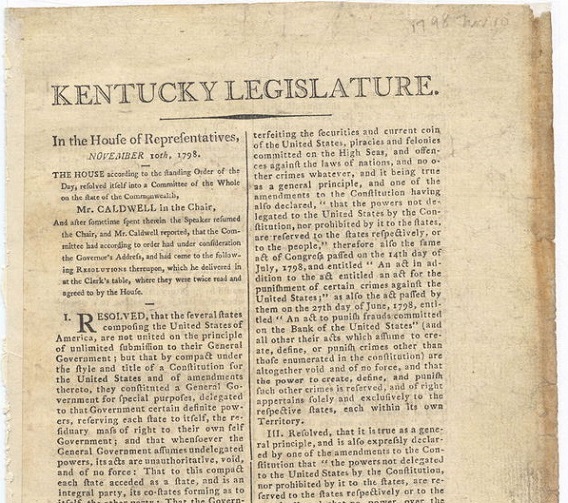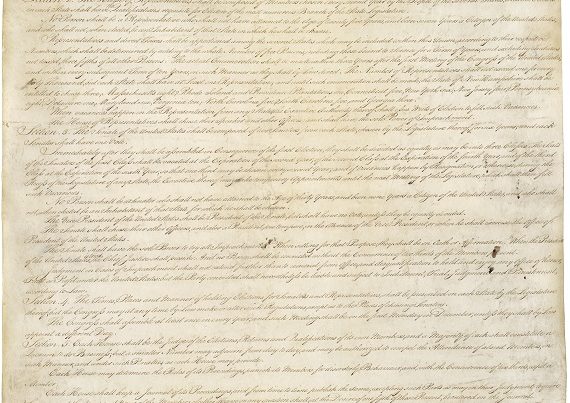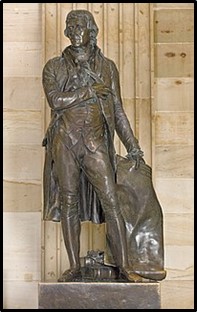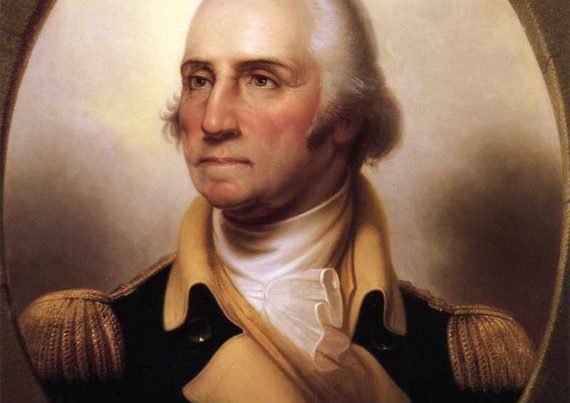Nullification, also known as State interposition, is controversial because it challenges the Supreme Court’s monopoly on constitutional interpretation. The argument behind nullification is that the States—as parties to the compact that created the federal government—have a right to interpret the Constitution and veto acts where the federal government exceeds its delegated power. Genuine nullification involves a State’s declaration of unconstitutionality and obstruction of that federal law within its territory.
The majority of historians and legal scholars today dismiss nullification, but they rarely engage the arguments in support of the practice. Here are 10 of their most common objections to nullification, followed by a refutation.
(1) Nullification does not work.
This is false. The best example of nullification was carried out by South Carolina during the Nullification Crisis of 1832-33. The federal government had instituted a tariff policy that particularly harmed the South, culminating in the 1828 “Tariff of Abominations.” This led John C. Calhoun to anonymously draft the South Carolina Exposition and Protest in 1828, with the Protest being a shorter document adopted by the State legislature. South Carolina was finally able to form a convention in 1832 that nullified the 1828 tariff and its slightly reduced version of 1832. Though President Andrew Jackson threatened force, South Carolina was successful in reducing the tariff.
Also, a modified form of nullification is working today where States refuse to enforce federal laws (termed by some as “neo-nullification”). This has been enabled by the Supreme Court’s anti-commandeering rulings in New York v. United States (1992) and Printz v. United States (1997), where the Court held that the federal government cannot commandeer State officials or State legislatures to enforce federal law. This is behind the movement of States to legalize marijuana.
(2) The Virginia and Kentucky Resolutions of 1798 and 1799 were rejected by the other States.
This is not the full story. It is true that no State supported the Resolutions and several denounced them. However, many of the other States were dominated by Federalists, the party in power in Congress that passed the Alien and Sedition Acts of 1798. It would be expected that Federalists would not support Resolutions that declared Federalist legislation to be unconstitutional. More importantly, some of the same States that rejected the Virginia and Kentucky Resolutions appealed to their very language less than a decade later in response to Jefferson’s embargo in 1807. Governor Trumbull of Connecticut advocated interposition, as did the Rhode Island legislature. The New England States also appealed to the Principles of ’98 during the War of 1812. The Massachusetts legislature called the embargo laws “unconstitutional and void” and spoke of the duty to interpose when the “compact” is violated. That some of the States sought to use the same arguments for nullification only 10 to 15 years later is evidence that the denouncement of the Resolutions was more a political issue than a rejection of their principles.
(3) The interpretation of the Constitution belongs to the Supreme Court.
This is false. Congress and the president also have the right—in fact the obligation—to interpret and uphold the Constitution. Congress is not supposed to pass laws that violate the Constitution, and the president is supposed to veto laws that violate the Constitution. As President Andrew Jackson said in his veto message on the bank bill in 1832, “The Congress, the Executive, and the Court must each for itself be guided by its own opinion of the Constitution. Each public officer who takes an oath to support the Constitution swears that he will support it as he understands it, and not as it is understood by others . . . The opinion of the judges has no more authority over Congress than the opinion of Congress has over the judges, and on that point the President is independent of both.”
The argument for nullification is that, in addition to the three branches of the federal government, the States also have the right to interpret the Constitution, for they are the parties to the compact that created the federal government. Nullification thus seeks to function as a check on the federal government when it fails to check itself. As the Kentucky Resolutions of 1798 argued,
the government created by this compact was not made the exclusive or final judge of the extent of the powers delegated to itself; since that would have made its discretion, and not the Constitution, the measure of its powers; but that, as in all other cases of compact among powers having no common judge, each party has an equal right to judge for itself [emphasis added].
If the federal government has a monopoly on constitutional interpretation, it results in the people of the States being governed by the “discretion” of their rulers rather than the Constitution. If the Constitution is to be the measure of the powers of the federal government, then the States that created that federal government must have the equal right to judge whether the actions of the federal government are constitutional.
(4) The Supreme Court ruled against nullification.
This is true, but it does not settle the issue. The Supreme Court declared nullification unconstitutional in Cooper v. Aaron (1958) when Southern States sought to oppose the prior ruling of Brown v. Board of Education (1954). However, the Supreme Court’s ruling assumes the ultimate authority of the Court—the very thing nullification seeks to challenge! As it has so often done throughout its history, the Court simply asserted its own authority. The Court here is guilty of circular reasoning, and there is nothing preventing the States from also proclaiming their own authority as the ultimate interpreter of the Constitution. However, the States have an argument beyond simply asserting their own authority, for the States are the parties that ratified the Constitution and created the federal government. Thus the States created the federal judiciary and are foundational to it. Without the States, there is no federal judiciary. But without the federal judiciary, the States still remain.
(5) Nullification is tied with slavery.
This is false. The Virginia and Kentucky Resolutions had nothing to do with slavery, nor did the Nullification Crisis of 1832-33. It is irrelevant that Thomas Jefferson owned slaves or that John C. Calhoun defended slavery. These things had nothing to do with their nullification efforts. Moreover, Northern States used nullification in opposition to slavery. In 1855, the Wisconsin Supreme Court nullified the Fugitive Slave Act of 1850 (the U.S. Supreme Court overruled the Wisconsin court). Interestingly, Northern nullification of the fugitive slave acts was a factor in the secession of the Southern States. South Carolina’s declaration of secession in 1860 cited this—“But an increasing hostility on the part of the non-slaveholding States to the institution of slavery, has led to a disregard of their obligations, and the laws of the General Government have ceased to effect the objects of the Constitution. The States . . . have enacted laws which either nullify the Acts of Congress or render useless any attempt to execute them.” So no, nullification is not tied with slavery but is a legal doctrine that stands on its own.
(6) The Civil War ended the possibility of nullification.
The “Civil War” (1861-1865) did strengthen the power of the federal government at the expense of the States—though most of this was unconstitutional. Over time, the federal government used this power to do away with State militias and make the States financially dependent on the federal government through the redistribution of tax money. So yes, as a result of the war, it is more difficult for States to assert their authority and nullify federal acts. However, it is still possible, and there have been nullification efforts post-1865, including attempts at nullifying Brown v. Board of Education (1954) and the current movement for States to legalize marijuana despite federal prohibition. More importantly, the arguments for nullification are still the same. The Union is still a compact between the States, and as parties to this compact, the States have the right to interpret the Constitution.
(7) The Supremacy Clause means States cannot nullify federal laws.
The Supremacy Clause, found in Article VI of the Constitution, states: “This Constitution, and the Laws of the United States which shall be made in Pursuance thereof; and all Treaties made, or which shall be made, under the Authority of the United States, shall be the supreme Law of the Land; and the Judges in every State shall be bound thereby, any Thing in the Constitution or Laws of any State to the Contrary notwithstanding” [emphasis added]. This means federal laws are supreme over State laws so long as those laws are “in pursuance” of the Constitution. In other words, federal supremacy only applies to constitutional laws. Laws that are not pursuant to the Constitution are “null and void,” as even the nationalists Alexander Hamilton and John Marshall said.
Hamilton said in Federalist No. 33, “But it will not follow from this doctrine that acts of the large society which are NOT PURSUANT to its constitutional powers, but which are invasions of the residuary authorities of the smaller societies, will become the supreme law of the land. These will be merely acts of usurpation, and will deserve to be treated as such.” In defending judicial review (the power to veto Congress) in Marbury v. Madison (1803), Marshall said of the Supremacy Clause:
It is also not entirely unworthy of observation that, in declaring what shall be the supreme law of the land, the constitution itself is first mentioned; and not laws of the United States generally, but those only which shall be made in pursuance of the constitution, have that rank. Thus, the particular phraseology of the constitution of the United States confirms and strengthens the principle, supposed to be essential to all written constitutions, that a law repugnant to the constitution is void, and that courts, as well as other departments, are bound by that instrument [emphasis added].
Two of the most important nationalists in American history said that the Supremacy Clause only applies to constitutional laws and that an unconstitutional law is void. Nullification simply argues this declaration of unconstitutionality should be done by the States. States have a duty to declare acts unconstitutional and then obstruct their enforcement because they are void.
(8) States cannot interpret the Constitution because it was created by “the people.”
This is the nationalist view of the Union, and it is false. The preamble to the Constitution does speak of the “We the people,” but these are “the people of the . . . States.” The people of the individual States ratified the Constitution through their State conventions. It was not the people of all the States as one. The nationalist notion is erroneous based on the fact that the Constitution would only apply to the States that ratified it. Ratification by just nine of the 13 States was sufficient for the Constitution to go into effect (Article VII). And in fact, Rhode Island did not ratify the Constitution until 1790, almost two years after it went into effect. Hence, the people of a State that failed to ratify the Constitution would not be under the Constitution. Furthermore, Madison’s initial draft of the preamble said, “We the people of the States of . . .” and listed the States. But the Framers changed this because it was not certain that all the States would ratify the document. Thus it was the people through their State conventions that ratified the Constitution. And as such, the people of the States can convene to nullify unconstitutional federal acts (laws, court rulings, etc.).
(9) Nullification undermines the uniformity of the States and the effectiveness of federal laws.
The Constitution was not intended to provide uniformity among the States but to unify the States for a common purpose, namely commerce and defense. The Constitution was intended to open up free trade among the several States and to strengthen the military power of the federal government for defense. The limitations on States are few and are outlined in Article 1, Section 10. Thus the Constitution was designed to leave most issues to the States (made explicit in the Tenth Amendment), which would result in diversity among the States. As for the “effectiveness” of federal laws, nullification only aims at opposing unconstitutional federal laws. But if a law is unconstitutional, then undermining its effectiveness is the very goal of nullification!
(10) Nullification risks the States undermining constitutional laws.
This is a possibility, but it is unlikely. The federal government has very limited powers according to the Constitution, namely commerce and defense. There is little reason for a State to nullify a law that provides for free trade (commerce) or provides protection for the State (defense). Furthermore, the potential for error or abuse by the States in regards to nullification is minimal in contrast to the actual abuse by the federal government, which has expanded its powers well beyond those granted by the Constitution. A State could nullify a perfectly constitutional law (or many!) and this would not even come close to the federal government’s long record of violating the Constitution. And if nullification should be rejected because it risks violating the Constitution, then why not also reject the authority of the Supreme Court because it carries this same risk?
Judge Abel Upshur aptly responded to this criticism of nullification in his 1833 pamphlet, An Exposition of the Virginia Resolutions of 1798. Upshur stated, “The worst possible result of nullification, even in the opinion of its bitterest opponents, is to dissolve the Union—and this result does not legitimately flow from it.” It is the “alternative which they propose” that is the greater concern. If the States cannot check the federal government, this “establishes an absolute despotism, which not only dissolves the Union, but establishes the worst possible form of Government upon its ruins.” Upshur concluded, “Thus it appears that nullification is much less apt to be abused, than the alternative remedy, and when abused, its consequences are infinitely less to be deprecated. Of the two evils, I choose the least.” In other words, nullification is needed to uphold the Constitution as ratified.







